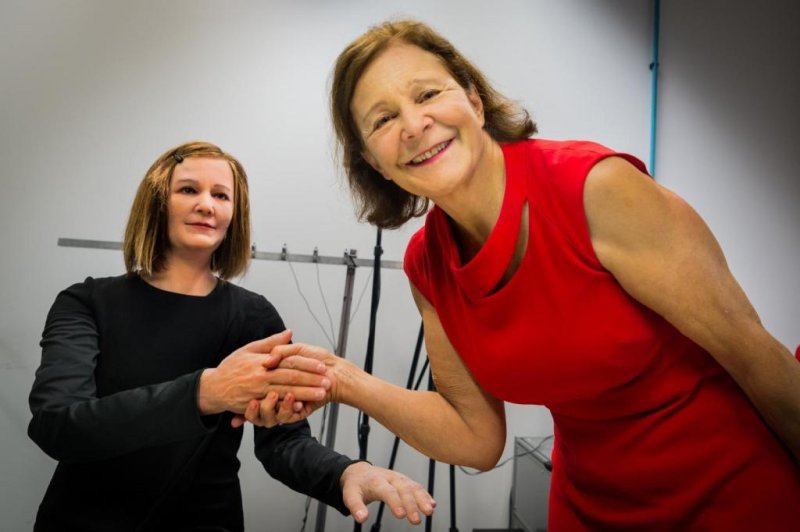1 of 2 | Nadia Thalmann shakes hands with Nadine, a humanoid robot with social intelligence. Photo by NTU Singapore
SINGAPORE, Dec. 30 (UPI) -- On Tuesday, engineers at Nanyang Technological University in Singapore unveiled an emotionally intelligent robot. The robot, named Nadine, has been employed as a receptionist at the university to test her skills.
Powered by a software technology similar to Apple's interactive interface Siri, Nadine talks and acts like a human. Deployed with her own personality, Nadine can use her social intelligence to express emotions and change moods in accordance with the topic and tone of conversation.
Her memory allows her to recognize people she's met before and recall what was said during previous conversations.
"This is somewhat like a real companion that is always with you and conscious of what is happening," Nadia Thalmann, a robotics professor NTU's School of Computer Engineering, explained in a press release. "So in future, these socially intelligent robots could be like C-3PO, the iconic golden droid from Star Wars, with knowledge of language and etiquette."
Thalmann says in the future social robots like Nadine could become office assistants or serve as companions and caretakers for the children and the elderly at home.
"[They could] even serve as a platform for healthcare services in future," Thalmann said.
For now, Nadine will simply talk to students and faculty at Nanyang.
Thalmann and her colleagues also introduced EDGAR, a tele-presence robot capable of replicating the movements of its human user in real time. Using a webcam, EDGAR can be controlled from anywhere in the world -- at least anywhere with Internet.
EDGAR can also interact with humans, greeting them, offering a smile and reading a programmed script.
Engineering professor Gerald Seet thinks EDGAR and robots like him could prove useful in education, business and tourism industries.
"Telepresence provides an additional dimension to mobility," said Seet. "The user may project his or her physical presence at one or more locations simultaneously, meaning that geography is no longer an obstacle."
"In future, a renowned educator giving lectures or classes to large groups of people in different locations at the same time could become commonplace," he added. "Or you could attend classes or business meetings all over the world using robot proxies, saving time and travel costs."















